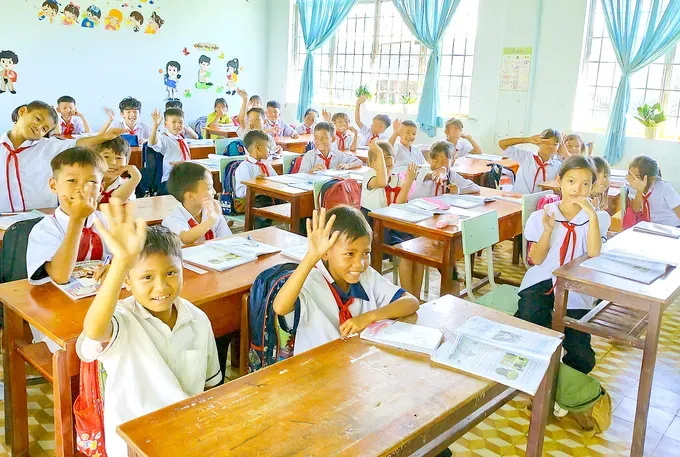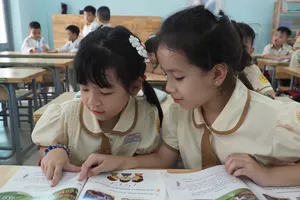

Each day, from Mong Cai to Ca Mau, tens of thousands of students cross mountains, trek through forests, or navigate rivers to reach their classrooms. To keep the flame of learning alive for these young “green shoots” of the nation, the road ahead remains full of obstacles.
Story in the Central Highlands
As dusk falls, 13-year-old H Nghe Knul from Drang Phoc Village in Dak Lak Province’s Buon Don Commune, returns home from the forest, her work clothes stained with dirt. Without even stopping to wash, she rushes to the kitchen to light a fire and cook dinner. The heavy rain has soaked the firewood she stored in the corner of the house, and it takes her a long while to coax a flame to life. After wandering the forest all day, H Nghe manages to collect a good amount of bamboo shoots which is sold at about VND50,000 (US$1.89) - just enough to buy a few kilograms of rice.
Her mother passed away early, her father has no steady job, and their family owns no farmland, so H Nghe must fend for herself. This year, she entered sixth grade at Vo Thi Sau Secondary School in the commune center more than 10 kilometers from her home. The road to school is an arduous journey. Among her six siblings, H Nghe is the only one who studies well while the others stopped after learning basic literacy to work and support the family.
“I want to go to school. I want to study. I dream of becoming a teacher so I can escape poverty,” she says softly, “but the road to school… it’s so far.”
In Drang Phoc Village, poverty stands in the way of many children’s dreams of education. Take, for example, 12-year-old Y Doi Hmok, who is entering fifth grade this year. His class at Y Jut Primary School is just a few steps from home, yet he often misses school. His mother, H Ne Ra Hmok, is disabled and unable to work much. Every day, Y Doi spends one half of the day at school and the other in the forest gathering bamboo shoots to feed his family of four. When the rice runs out, he heads back into the woods to earn their next meal. His education, like the flickering flame of a candle, struggles to stay alight.
According to the results of the third survey on the socio-economic information of 53 ethnic minorities published by the Ministry of Ethnic and Religious Affairs in July 2025, the average distance from home to school for students from ethnic minority communities in border areas is 2.6 km for primary education and 4.7 km for secondary education. The excessive distance from home to school has restricted ethnic minority students' access to public educational services, leading to frequent school dropouts.
Y Cuong Nie, Village elder of Drang Phoc, calculated that the village has 140 households with approximately 500 inhabitants including about 100 students at all grades, of which about 20 percent are poor or near-poor households. Since the village is isolated from the communal center, students face difficulties in their education. For primary school students, Y Jut Primary School has established a sub-school within the village, ensuring their attendance. However, upon transitioning to secondary school, the distance is too far which is up to 20 km causing many students to drop out midway.
The issue of inadequate schools is not unique to Dak Lak Province but is also prevalent in many other areas. In the border commune of Ia Mo of Gia Lai Province, students have had to rely on schools in other communes for decades. Students from Khon village must attend school in Ia Lau Commune; students from Ring village - part of Ia Mo Commune must attend schools in the neighboring commune.
Secretary Nguyen Van Toan of the Party Cell cum village elder stated that this school year, about 80 students are still attending school elsewhere. Parents choose to send their children to Ia Lop Commune because the route is nearly 15 km shorter than traveling to the center of Ia Mo Commune.
Concerns about unsafe school environments
In the flood-prone region of Central Vietnam, the deluge at the end of July severely impacted My Ly commune in Nghe An province. In the education sector alone, numerous facilities suffered extensive damage, including one school that was destroyed.

Principal Tran Sy Ha of My Ly 2 Semi-boarding Ethnic Minority Primary School recounted how the floodwaters, accompanied by mud and debris, devastated and buried the single-story classrooms and the first floor of the two-story building. All teaching equipment, textbooks, and food supplies for the semi-boarding students were entirely ruined. Teachers had to relocate 188 students to study at smaller satellite schools, conducting classes in the community cultural house. The flood also caused significant damage to the homes of 20 teachers, with 9 educators losing their houses entirely.
Remembering this devastating flood, teacher Tran Sy Ha said that other communes like Na Ngoi and Keng Du face floods every year, suffering severe losses each time. Having been born and raised in this area, teachers can't simply leave. They may wish to depart, but nowhere they can go when the entire region is predominantly steep mountains, prone to landslides.
The road leading to Vo Chi Cong High School in Hung Son border Commune of Da Nang City is rugged with rocks and has many deeply sunken sections, requiring motorcyclists to grip the handlebars tightly to avoid slipping. On sudden rainy days, the road becomes as slippery as grease, and each curve along the mountainside poses a dangerous challenge for both teachers and students. According to Principal Nguyen Cong Tuoi of Vo Chi Cong High School, after the storm in 2020, the school experienced landslides, forcing 272 teachers and students to study elsewhere for nearly five years.
A new school building has been completed, but the access road is still under construction, making it difficult for teachers and students to reach the school. The reality in the mountainous border communes of Da Nang indicates that the treacherous terrain remains the greatest barrier.
During the rainy season, landslides and flash floods frequently disrupt access to school, with teachers sometimes having to carry students across streams, posing risks for both. Many schools, despite standing resiliently, still face the threat of roof collapses and structural failures when storms strike.
























